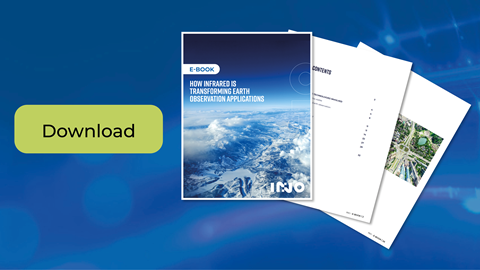Why Infrared Matters for Earth Observation
Infrared (IR) sensors have become critical for understanding and protecting our planet. Unlike visible light, infrared detects temperature and radiation patterns, enabling constant monitoring, even at night or through clouds.
This makes infrared indispensable for:
- Tracking climate change and natural disasters,
- Monitoring air and water quality and detecting gas leaks,
- Preventing forest fires with early detection,
- Supporting precision agriculture for higher yields and sustainability,
- Ensuring safer infrastructure by identifying risks before failure.
What You’ll Learn in the E-Book
Our comprehensive guide, How Infrared is Transforming Earth Observation Applications, explores real-world use cases:
- Meteorology & Climatology: Predicting extreme weather, monitoring permafrost, and tracking hurricanes.
- Environment: Detecting forest fires, pollution, volcanic ash, and water quality variations.
- Agriculture: Monitoring crop health, soil quality, and harvest optimization.
- Infrastructure: Identifying heat stress, leaks, and structural weaknesses in bridges, tunnels, and pipelines.
- Other Applications: Maritime surveillance, mineral detection, and sensitive area monitoring.

Who Should Read This E-Book?
This guide is designed for governments and decision-makers, environmental agencies, agricultural professionals, infrastructure managers, and researchers who want to leverage infrared technology to better understand, monitor, and protect our planet.
Technical level
![]()
What the experts are saying
This e-book is an essential resource for anyone looking to understand the impact of infrared remote sensing on Earth observation. The practical examples presented pave the way for new perspectives in environmental analysis.
Frequently Asked Questions
What is infrared in Earth observation?
Infrared is electromagnetic radiation beyond the visible spectrum, used to measure temperature and detect environmental changes remotely.
How is infrared different from traditional optical imaging?
Infrared imaging detects heat signatures rather than visible light, making it effective at night, through clouds, or in poor visibility.
What are real-world applications of infrared in Earth observation?
Disaster prediction, environmental monitoring, sustainable agriculture, infrastructure safety, maritime surveillance, and mineral exploration.
Why download this e-book from INO?
It provides expert insights, practical examples, and explains how cutting-edge IR sensors are already transforming Earth monitoring.